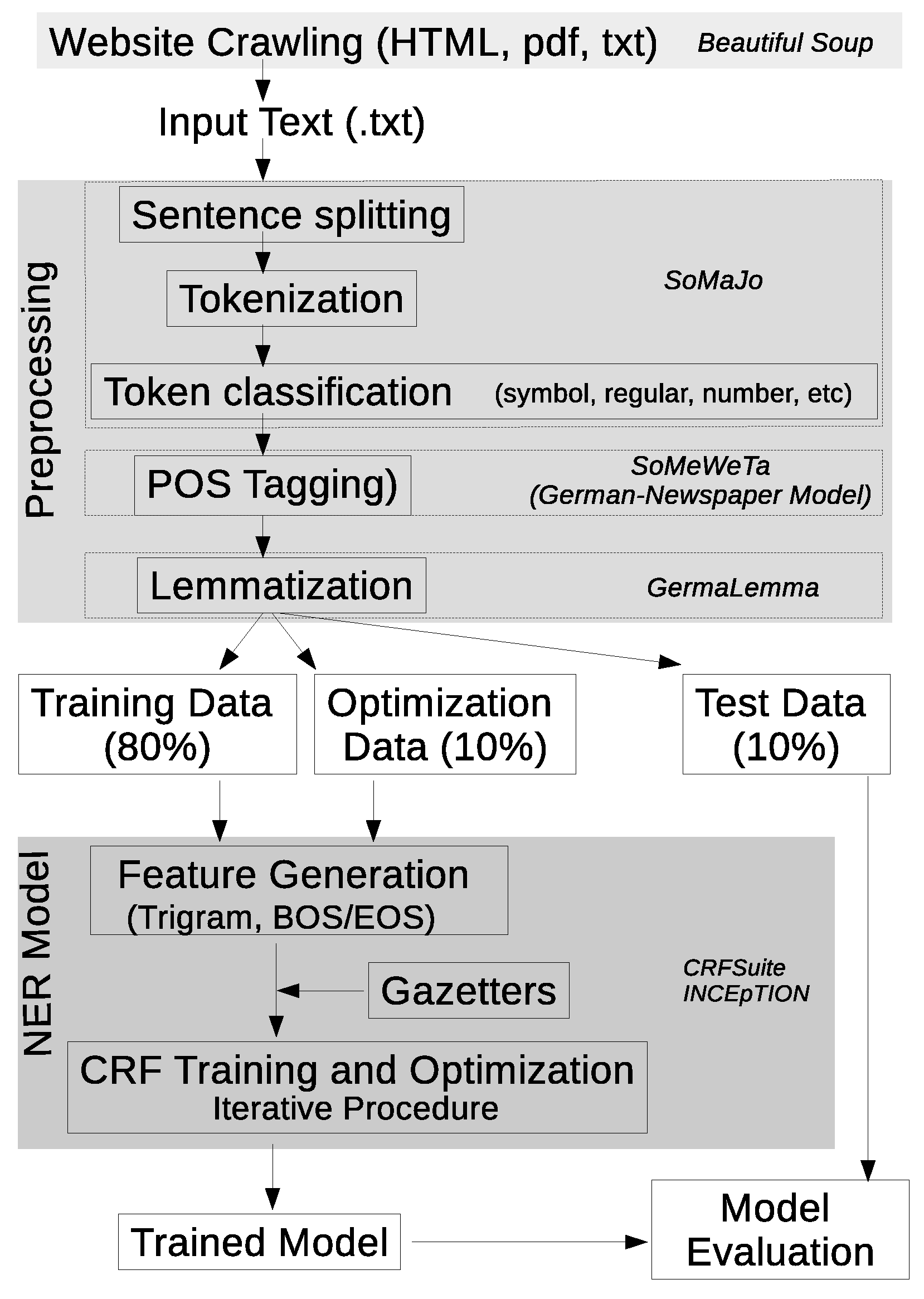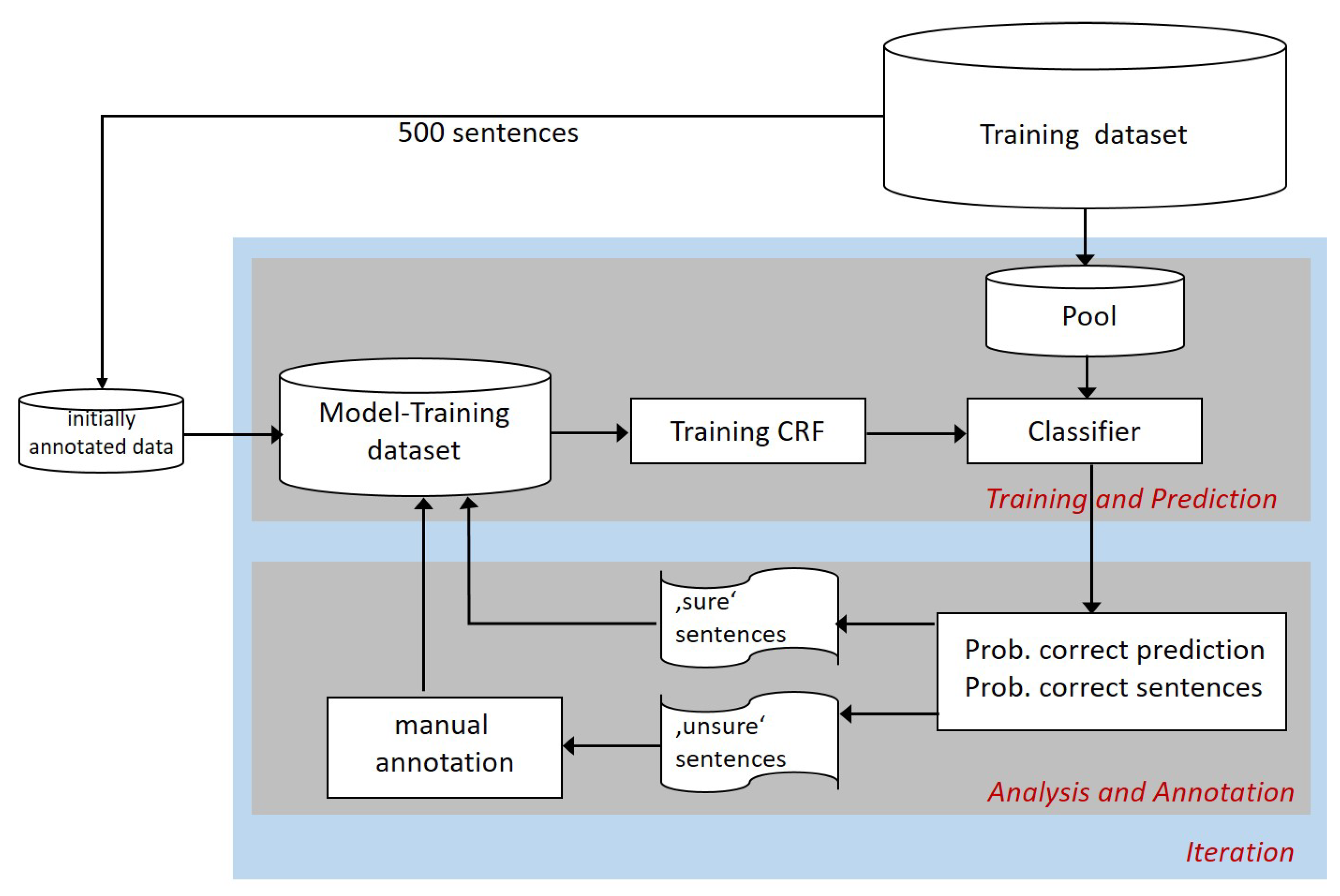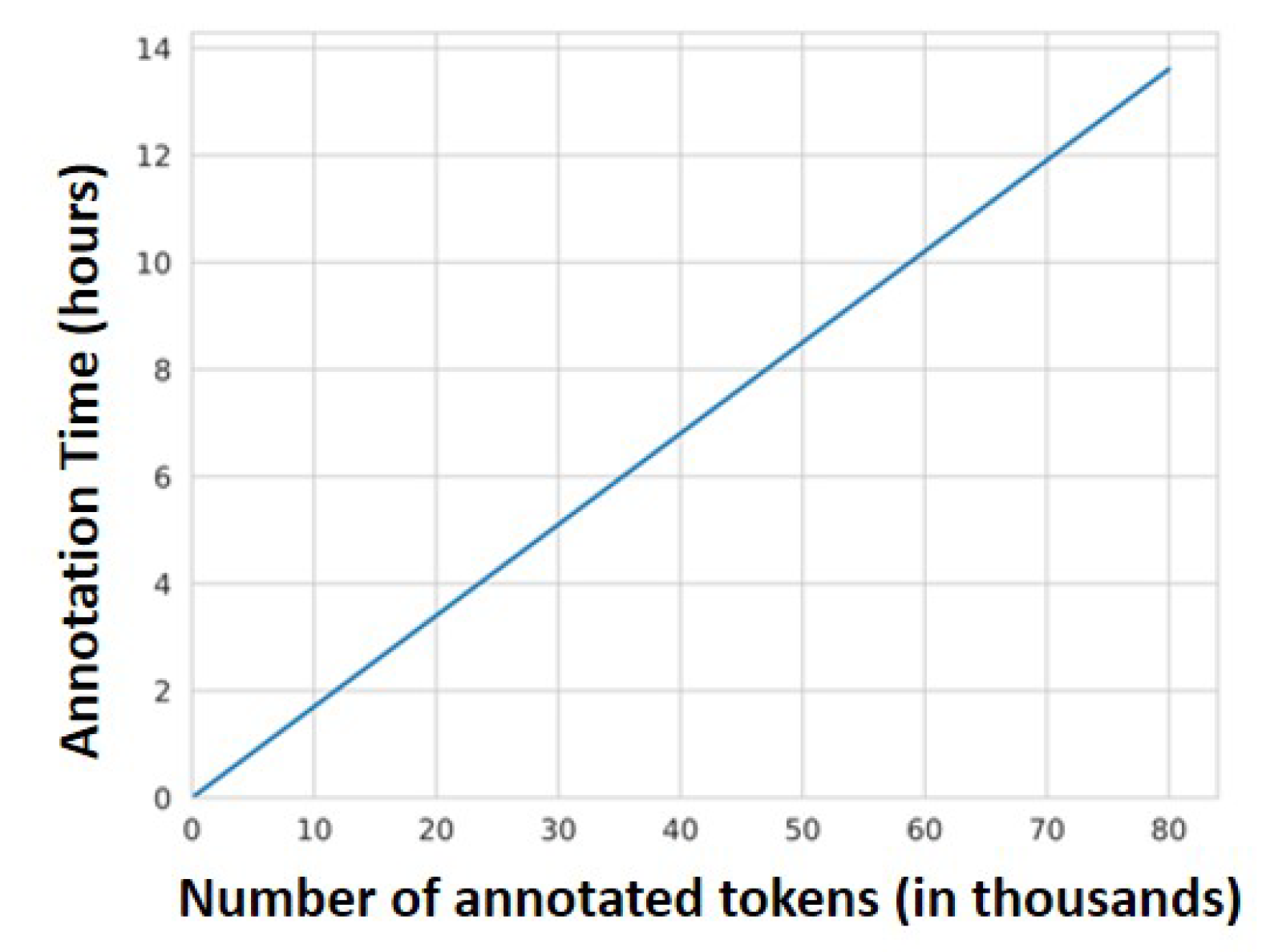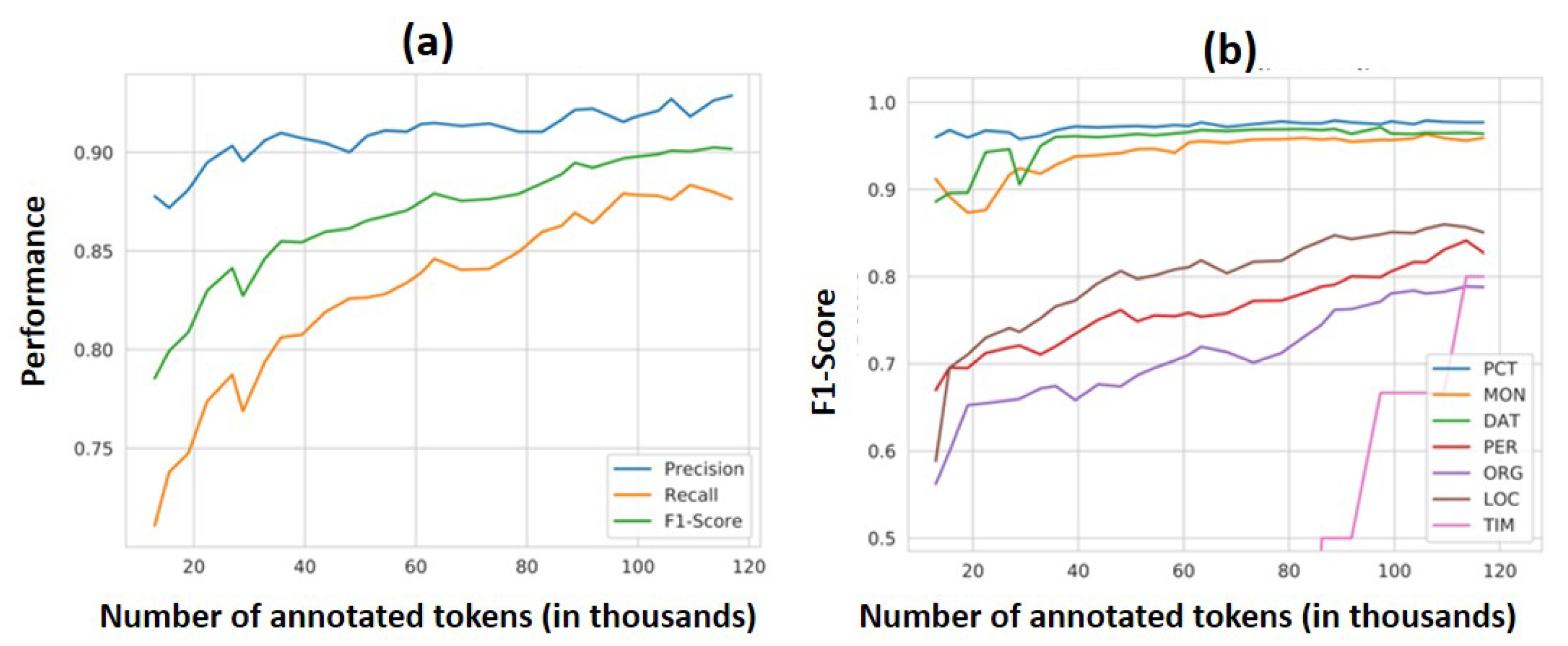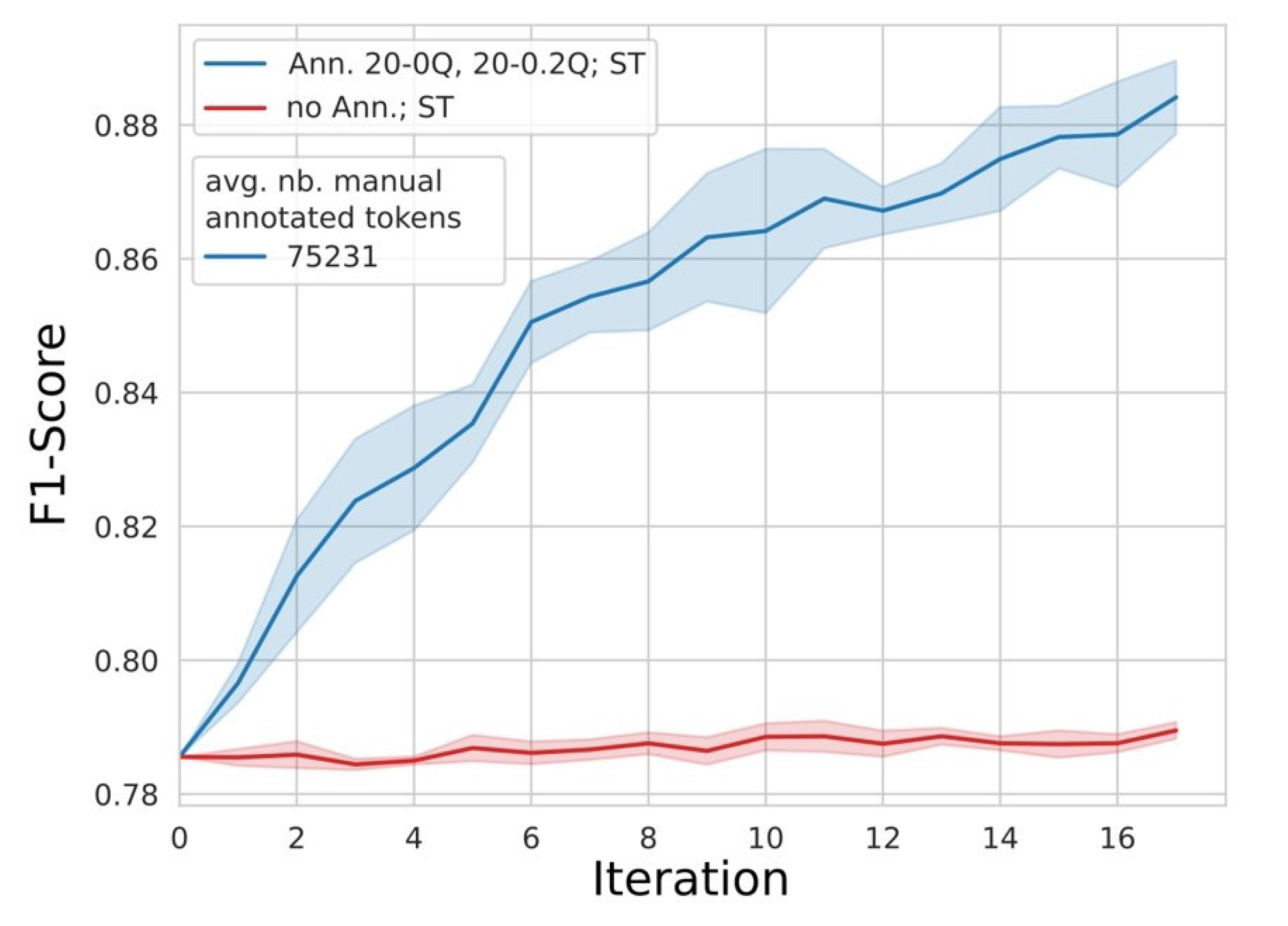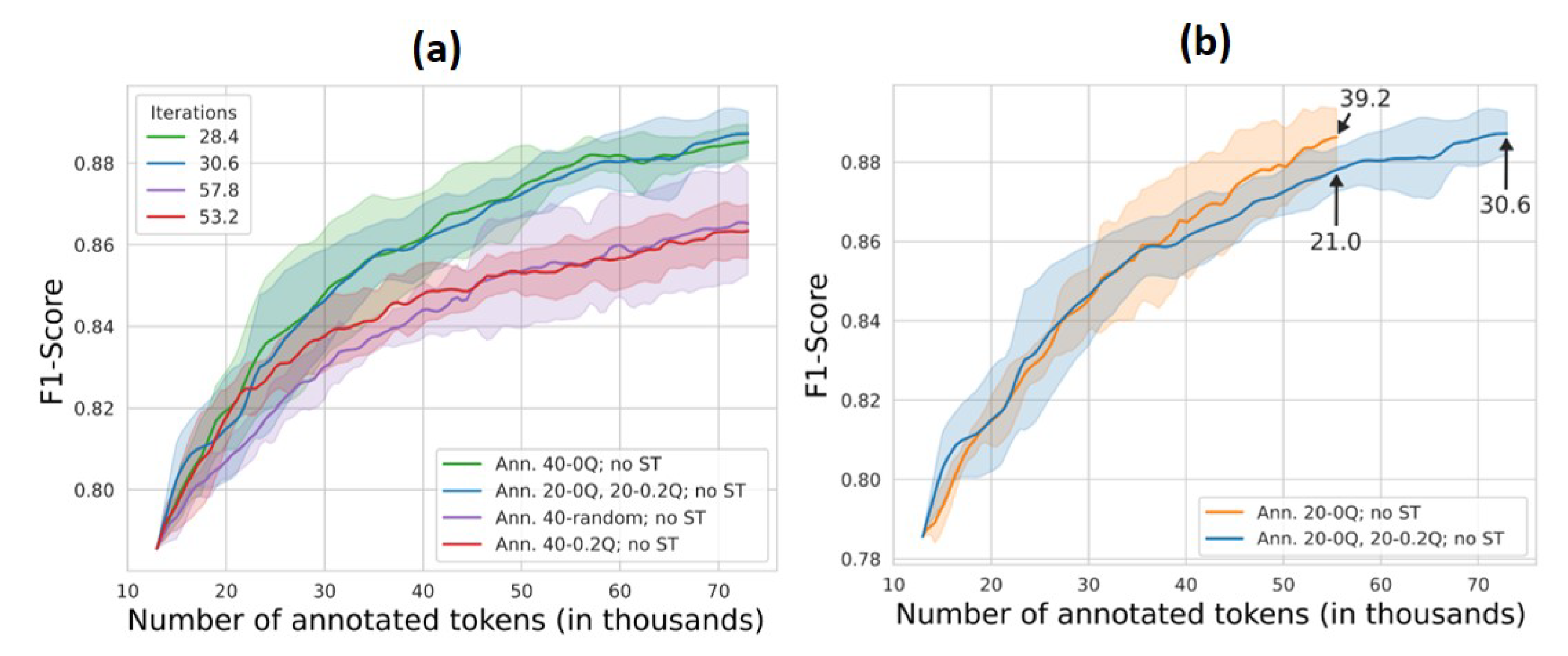1. Introduction
The analysis of large amounts of unstructured text information can be supported and sped up by machine-learning-based methods. The successful use of such methods requires, however, the training of underlying machine learning models with accurately annotated or labelled text datasets [
1]—that is, datasets containing metadata information on predefined information units. Model training needs to be conducted on domain-specific information or datasets that are appropriate to the information needs. For numerous applications regarding the identification and annotation of information units or entities such as persons, organisations, or location names in texts, a process called named entity recognition (NER) is highly relevant [
2]. Accurate labelling of such entities is generally achieved by performing the annotation manually, because domain-specific knowledge is often required [
3]—for example, to annotate medical terms across large amounts of medical records. Such manual annotation processing is, however, time-intensive, requiring a significant amount of human work. This becomes even more critical when analysing and annotating large numbers of text documents. Similar to other domains, the security sector also faces the challenge of analysing increasing amounts of heterogeneous information in an unstructured form.
Reduction of the time and effort required to label text datasets has been sought by employing machine-learning-based methods to perform NER automatically. Comprehensive reviews on NER discussing traditional approaches as well as machine-learning- and deep-learning-based approaches for NER can be found in [
2,
4]. State-of-the-art models to perform supervised NER include Conditional Random Fields (CRF) [
3,
5,
6,
7] and Long Short-Term Memory Networks (LSTMs) [
7,
8,
9,
10]. These have been reported to achieve good performance for English news texts (e.g., F1 Score of 0.9; [
8,
9,
10]) but to perform poorer for German texts [
11,
12]. Ref. [
7] trained and tested CRFs and Bilateral LSTMS (BiLSTM) on a dataset composed of German legal documents. They reported that BiLSTMs achieved superior performance with F1-scores of 95.95 for coarse-grained NER classes, compared with the 93.23 achieved by CRFs; further, they reported on the effect of unbalanced entity representations on model performance.
In addition to this, and despite the good performance reported, these models still need to be trained with manually labelled datasets in a supervised approach, with manual labelling remaining important due to domain specificities. This means that they only partially solve the need for reducing manual labour. In order to address this issue, previous works have complemented the above models with self-learning and or active learning approaches [
13,
14]. The former starts with an initial small set of manually labelled sentences for training and extends this set iteratively with sentences that are automatically labelled by the model in an unsupervised way. Generally, sentences with a high likelihood of a correct annotation are added. For instance, for probabilistic models such as CRFs, sentences are added with a high probability of correct classification of entities by the model [
14,
15]. Implementation of self-training, however, depends on several parameters, and generalisation of the trained models is not given [
16]. In active learning, sentences are chosen from the pool of data for manual annotation before being added to the set of sentences for training. Sentences are selected by the model such as to maximise information learning by the model and minimise the amount of manual annotation required for training. This approach has been successfully employed by Tran and colleagues on Twitter posts in English [
17].
The extent to which this method can contribute to substantially reduce the manual annotation of texts in other domains or languages (e.g., German) remains unclear, since the language usage and diversity of information that are dealt with are very different from that of Twitter posts. It is also unclear as to the extent to which these methods may support the recognition of unrepresented entities, as reported by [
7].
In the current work, we investigated the extent to which a CRF-based algorithm in combination with active learning and self-training contributes to more efficient processing and consequent analysis of information contained in large amounts of German texts in a given domain. A further advantage is that this approach is independent of the domain or of the specific entities analysed, and is therefore applicable to different contexts and use cases. Despite the higher performance of BiLSTMs relative to CRFs reported previously, the latter was chosen to investigate the contribution of active and self-learning to the annotation effort of datasets since, as probabilistic and discriminative models, CRFs retrieve the probability of a possible labelling sequence for a given sequence of tokens [
18,
19], providing a means for selecting instances for active and self-learning. The CRF output probabilities are computed based on the syntactic structure and on observed variables for the token sequence given. By modelling probabilities, CRFs make iterative training of the model possible with a procedure encompassing a self-learning (i.e., unsupervised) component that supports an active learning (i.e., supervised) component via manual labelling of entities. In order to reduce the share of manual labelling required to train the model, it would be desirable/advantageous for the self-learning component to be the main contributor to the training of the model, i.e., to the improvement of the model performance. The influence of these two components on model training remains an open research question.
Investigating the contribution of these components on the training of a CRF model for NER was aimed not only at assessing the pros and cons of both learning approaches, but also to investigate the extent to which the share of manual labelling can be reduced and replaced by training via unsupervised learning (that is, self-training). For this purpose, we trained several CRF models, each with different implementations of active and self-learning, and compared their performance for NER. In addition to this, we estimated the efficiency of such a procedure by estimating the fraction of time required for manual and automatic labelling separately. The latter includes the computation time for self-learning and for CRF training.
2. Materials and Methods
2.1. Dataset
The dataset is composed by 1082 text documents, encompassing 60,000 sentences and 1,567,625 tokens, all in German language. The dataset was self-generated by downloading newspaper articles and documents from the internet, all freely available at the time of download. Economy and finance subjects were chosen in terms of domain, since, in relation to a dataset composed of twitter posts for instance, it allowed the use of a relatively wide range of types of documents and formal language use. The dataset contains articles from online newspapers on financial areas (31% of the total number of tokens in the dataset), to reports from different financial institutions (31% of the dataset tokens), bulletins of governmental institutions (similarly, 31%), and press releases and other types of documents (about 7%). Web crawling of websites was performed with the Python tool Beautiful Soup
https://www.crummy.com/software/BeautifulSoup/ accessed on 1 March 2020.
2.2. Data Preprocessing
The content of the original documents—in .HTML, .pdf, and .txt formats—was first converted in .txt format before being processed with the standard natural language processing (NLP) pipeline: sentence splitting, tokenization, and classification of tokens (e.g., symbol, regular, number), which was performed with the SoMaJo tool [
20], whilst Part-Of-Speech tagging (POS-tagging) was conducted with the SoMeWeTa tool [
21] and considering the German Newspaper Model. Lemmatization was also performed, for which the GermaLemma [
22] tool specific for the German language was used. For tokens for which no lemma can be defined (for example, proper names or punctuation marks), the token itself was assigned as lemma (
Figure 1).
2.3. Training, Optimization and Evaluation Datasets
The dataset was divided document-wise into a (1) training, (2) an optimisation, and (3) an evaluation dataset, each containing approximately 80%, 10%, and 10% of the sentences, respectively. The training dataset was used for model training purposes only. The optimisation set was employed on each iteration to select the optimal model parameters, whilst the evaluation set formed the independent set of data used for the final evaluation of model performance. The two latter datasets were completely manually annotated, for which we used the tool INCEpTION [
23]. Labels consisted of the seven entities described in the sixth Message Understanding Conference (MUC-6) [
24]. The three datasets have a similar composition in terms of document types, for example, the proportion of reports and newspaper articles. This similarity is reflected in the proportion of tokens belonging to each entity class and in the proportion of annotated tokens, which are similar for both the Optimization and Evaluation datasets (
Table 1). The number of tokens, instead of the number of entities belonging to a class, was considered here since these two variables can, in several cases, be different; for example, in the case of the German federal state Nordrhein-Westfalen. Furthermore, there are tokens that can belong simultaneously to different entity classes; for example, the term Germany is not only a location (LOC) but, depending on the context, can also refer to a governmental institution (ORG).
2.4. Iterative Procedure for Annotation
The iterative procedure started with the manual annotation of a small set of 500 sentences randomly selected from the sentences belonging to the training dataset (
Figure 2). This set of sentences contained 12,954 tokens, 959 of which were labelled as belonging to an entity. This set constituted the first ‘Model-Training dataset’ used, during the ‘Training and Prediction’ part of the procedure, to train an initial CRF model.
The initially trained model was then employed to classify entities in a pool of sentences randomly selected from the training dataset. This pool of sentences, newly generated during each iteration, contained 10x the number of sentences to be added to the ‘model-training dataset’ per iteration. In case not enough sentences were available for annotation in the training dataset, the pool-size was automatically reduced, with all sentences of the pool being added to the ‘Model-training dataset’. It should be noticed that a given sentence was either part of the initial model training dataset, part of the pool, or part of the set of unlabelled sentences left in the training dataset; these three groups of data never superposed during the iterative procedure.
After the ‘Training and Prediction’ step, new data were annotated either manually or automatically in the ‘Analysis and Annotation’ step before being added to the model training data. The aim of this step was, firstly, to identify sentences with the highest probability of correct classification by the model. In each iteration, these ‘sure sentences’ were automatically annotated for entities by the model and added to the model training dataset without a manual check (self-training). Secondly, ‘unsure sentences’ with a low probability of correct classification for potential entities contained within them were identified by the model and presented for manual annotation in each iteration. This iterative manual annotation and expansion of the model training dataset represents the active learning component of the model training procedure. The prediction of the uncertainties of the correct classification was based upon the probabilities delivered by the CRF as a probabilistic model. The ‘sure sentences’ were those sentences with the highest probability of correct classification by the model. The ‘unsure sentences’ came from the lower quantiles of the probability distribution of the uncertainties provided by the model. During the automatic, self-training component of data annotation for the model training dataset, two types of sentences were distinguished—those for which at least one entity was predicted and those without predicted entities. To avoid a shift in the model training dataset to ‘sure’ sentences without entities, the automatically annotated self-training data added was set to be proportional to the number of sentences with at least one entity in the initially annotated training dataset, such that 48.8% of the sentences in the initially annotated data contained entities.
This procedure of ‘training and prediction’ and ‘analysis and annotation’ was implemented iteratively to expand the annotated data as a basis for iterative model training with the overall goal of efficiently producing a model with high accuracy for NER. As such, the size of the model training dataset grew and the size of the training dataset shrank during each iteration. Rather than train the algorithm until no more sentences were left in the training dataset, we stopped the iterative training procedure after confirmation of convergence of the model performance, i.e., after no visible increase in performance during the previous iterations was observed (see
Section 3).
2.5. Model Training and Fitting
Different token-associated variables and properties determined during preprocessing (
Table 2) were used as input to the CRF model during training to recognise entities in the corpus. Feature-based analyses were restricted to trigrams—that is, features were considered for the token in question as well as for the single tokens immediately next to it. For tokens at the beginning or end of sentences, only bigrams were used; the position of these tokens was coded with BOS/EOS variables (
Table 2). In addition to these features, the following gazetteers were also employed for NER training: a list of all countries, a list with German first names, and a list of date-related expressions (i.e., days, months, and seasons).
We employed the CRFsuite [
25] to implement a linear-chain (first-order Markov) CRF model in Python. The Limited-Memory-BFGS [
26] algorithm was used to train the model, with the maximum number of iterations set to 100 and allowing for all possible transition features. L1 and L2 regularisation was applied to improve micro-F1-based model quality (see
Section 2.7.1). Parameter selection was based on a parameter grid with L1 and L2 varying in the intervals [0.01, 0.02] and [0.2, 0.8], respectively. These intervals were based on results from preliminary model runs.
2.6. Experimental Design and Nomenclature
In order to answer our research questions relating to the influence of self-training- and active-learning-supported manual annotation on model performance as well as the time required to train an accurate model, we performed different experiments. In these, we focused on investigating the influence of the probability distribution used for selection of data for manual annotation and the number of data points manually annotated during each iteration, as we hypothesised that these factors would have the largest influence on information gain for the model and the time needed to train a good model. Additionally, we varied the size of the pool for annotation and investigated its effect on model performance.
2.6.1. Reference Experiment
To start with, we performed a reference experiment, which formed the basis for comparison with the subsequent experiments. This reference experiment was performed with self-training and active learning components. In this experiment, the number of automatically annotated data points during self-training was set to one tenth the number of data points in the model training data per iteration. Forty ‘unsure’ sentences were manually annotated during each iteration and added to the model training dataset. Twenty of these sentences were selected from the lowest quantile of the probability distribution of the uncertainties obtained by the model, and twenty sentences were selected from the 0.2 quantile upwards (‘Ann. 20-0Q, 20-0.2Q, ST’,
Table 3).
2.6.2. Influence of Self-Training on Model Performance
To assess the influence of self-training on model performance, we performed an experiment without manual annotation using only the self-training component in each iteration. In this experiment, the ‘sure’ sentences from the pool were selected for automatic annotation and added to the model training data during each iteration (‘no Ann., ST’,
Table 3). The number of automatically annotated data points during self-training was set to one tenth the number of data points in the model training data per iteration. This was contrasted with an experiment in which we only applied the active learning and manual annotation component without self-training. The manually annotated sentences were composed of twenty sentences selected from the lowest quantile of the probability distribution of the uncertainties obtained by the model, and twenty sentences from the 0.2-quantile upwards (‘Ann. 20-0Q, 20-0.2Q, no ST’,
Table 3).
In the experiments with only self-training or active learning, the size of the pool was comparatively smaller than in experiments with both components, as less sentences were added to the model training data in each iteration step. This was particularly the case for the experiment without self-training compared with the experiment with self-training, as the majority of added sentences in each iteration were derived from the self-training component during model training. In order to assess the effects of the comparative reduction in the model training dataset as a result of the omission of self-training on the model performance, we performed an experiment without self-training and with an adjusted pool size. The pool size in this experiment was set to the pool size in a comparable experiment with self-training, but only manual annotation was performed (‘Ann. 20-0Q, 20-0.2Q, no ST, large pool-size’,
Table 3). In a further experiment, we retained the pool size at a constant 400 sentences (i.e., 10 times the number of sentences annotated and added to the model training data) per iteration (‘Ann. 20-0Q, 20-0.2Q, no ST, small pool-size’,
Table 3).
2.6.3. Influence of Active-Learning-Supported Manual Annotation on Model Performance
In order to assess the effects of active learning on model performance, we performed several experiments training the algorithm using only manual annotation but without self-training for data annotation whilst varying the number of data points for annotation and the probabilities used to select the data points for annotation. In three experiments, we annotated 40 sentences manually per iteration, with the sentences being selected from either the lowest quantile (0Q), the 20% quantile (0.2Q), or an equal mixture of both upwards (‘Ann. 40-0Q, no ST’; ‘An. 40-0.2Q, no ST’; ‘Ann. 20-0Q, 20-0.2Q, no ST’,
Table 3) and added to the model training dataset. In a further experiment, we randomly selected 40 sentences for manual annotation in each iteration and added them to the model training dataset (‘Ann 40-random, no ST’,
Table 3). Lastly, we performed one experiment in which we annotated only the 20 ‘unsurest’ sentences from the lowest quantile for addition to the model training dataset in each iteration (‘Ann. 20-0Q no ST’,
Table 3).
2.7. Evaluation
2.7.1. Model Performance
We validated the model after each iteration using the optimisation dataset to assess the optimal L1 and L2 regularisation parameters (
Section 2.5) and learning progress, and then trained an optimal model using these parameters. The final evaluation was performed using the independent evaluation dataset. Model performance was based on precision, recall, and the micro-F1-score as the harmonic mean between the microprecision and microrecall. Subsequently, when we refer to the F1-score, we imply the micro-F1-score. Additionally, we calculated and examined the F1-score for each entity individually.
As the pool is randomly selected in each iteration, each experiment has a random driver, so that via repetition of experiments, we were able to estimate the variance in model performance for each experimental setting. The variance was calculated by repeating each experiment five times with the same variables but using a different random seed in each repetition and estimating the variance in model performance between repetitions reported as the 95% confidence interval in model performance across repetitions.
2.7.2. Time Estimation for the Model Training Procedure
As not only the model performance but also the time required to annotate the data and train a model is highly relevant to practical applications of NER in specialised domains such as the security sector, we estimated the time to fully train the model
ttrain for the most relevant experimental setting. This time interval needed to fully train the model is a function of both the annotation time for all annotated data points
tann and the calculation time for all iterations
tcalc. The latter can be estimated from the average time required to fit the model per iteration
tfit and the number of iterations
I per model:
Both the annotation time and the average time to fit the model per iteration were estimated during the experiments. The former was linearly related to the number of manually annotated tokens in each experiment (
Figure 3) and estimated at an average of 0.6 s per token. On the other hand, the latter depends on both the model training dataset, the optimal parameters, and the power of the CPU used to fit the model. The values here reported are based on modelling work that was performed using an Ubuntu-Linux OS V 18.04.1 with an Intel Core i7-8750H (6 core) processor and 32 GB RAM.
4. Discussion
4.1. General Model Performance and Individual Entity Recognition
The initial strong improvement to the model performance of the reference experiment (and subsequent experiments) is attributable to the growing number of annotated entities used to fit the model during each iteration so that the model learns from more data. Additionally, the introduction of annotated, particularly ‘unsure’ sentences to the model training dataset provides an additional source of relevant model information in each iteration. The manually annotated sentences were particularly long, containing at times over 100 tokens per sentence, and encompassing a large number of entities. Through the annotation of many entities with high uncertainty, the model parameter space is expanded in regions lacking information in the prior iteration, enabling efficient information growth for the model in particularly uncertain regions in the parameter space. Thus, our results confirm previous findings highlighting the importance of data selection for model performance beyond the benefit of having large collections of documents, for instance, using bootstrapping procedures [
27].
The comparatively lower performance of the model in recognising entities from the ENAMEX group can be attributed to the higher diversity of these entities in natural language usage than for entities from the NUMEX and TIMEX groups. NUMEX and TIMEX entities tend to have standard formats that can be well-estimated via regular expressions, whereas ENAMEX entities can be comprised of a vast, indeed nearly limitless, number of combinations of words, (invented) names, or acronyms. Thus, our results agree with previous reports of reduced vocabulary transfer of entities of the ENAMEX group, especially for persons and organisations [
7,
28,
29]. Some regular expressions, such as the acronym GmbH for proprietary limited companies, can be used to identify entities in the German language, but not all entities can be identified using such expressions and not all texts relating to such an entity use the appropriate acronym. The poor performance of the reference experimental model at recognising the TIMEX entities after a large number of annotated tokens can be attributed to its rare occurrence in the data: in the evaluation dataset, only twelve instances were manually annotated.
4.2. Influence of Self-Training on Model Performance
The lack of improvement in model performance during the experiment with only self-training as well as by the comparison of model performance with and without ST indicates that self-training, as performed in our experimental setting, had no positive effect on model performance. This result contrasts with the studies of Tran et al. [
17] and Steedman et al. [
30], which indicated that self-training and automatic data annotation can work in principle. We attribute our divergent results to the large number of highly diverse ENAMEX entities in our dataset, which are more difficult for NER models to recognise. Furthermore, the sentences analysed were collected from different sources, including texts from newspapers and from technical reports. The resulting dataset is likely to have a larger diversity in linguistic style analysed relative to previous works—for example, from analysing Twitter posts—and this may also affect model performance [
7]. However, more investigations are required to verify these hypotheses, and the effects of NLP models to recognise entities of different classes deserves more research. A possible research path involves the combination of CRFs with BiLSTMs, which can achieve state-of-the-art performance for specific language resources [
10] and be potentially useful in the identification of entities of the ENAMEX group, e.g., [
7,
31]. In addition, methodological approaches involving latent factor analysis may also contribute to improve computational efficiency and prediction accuracy of trained models for unseen data [
32,
33,
34,
35,
36].
In contrast to the lack of model improvement via (only) self-training, the marginal increase in model performance in the experiment without self-training and with a small pool size indicates that the model may learn better with the same number of annotated tokens. This is potentially associated with the higher number of iterations in these experiments, enabling more ‘unsure’ data points to be selected per iteration, driving better model performance.
4.3. Optimising Selection of Manually Annotated Sentences to Enhance Model Performance and Procedural Efficiency
The better performance of the models fitted with manually annotated data selected via active learning underscores our above results, indicating that annotation of ‘unsure’ sentences provides the most valuable information to the model. Although there was no statistical difference between the models based on manual annotation of sentences from the 0.2Q upwards or random sampling, the higher variance in model performance of the latter indicates that models based on random sampling of sentences are less reliable in their results than models created using uncertainty-based sampling in an active learning procedure. Compared with annotation of random sentences or sentences with a greater certainty estimated by the model, our results confirm that iterative manual annotation of highly uncertain sentences enhances final model performance and reliability as found in other studies [
14].
The better performance of the model built with the manual annotation of a smaller number of highly uncertain data points per iteration can be attributed to an increase in the number of iterations performed when training the model. The reduction in manually annotated tokens per iteration leads to an increase in the total number of iterations, with the model seeing the least certain and, therefore, most informative data points in each iteration. This allows the model to learn more frequently and adapt in the most uncertain regions of the parameter space during each iteration, leading to an overall increase in model performance.
An additional benefit to selecting the most uncertain sentences for manual annotation was the large reduction in the number of tokens required to be annotated overall, which leads to greatly increased efficiency in the model fitting process performed in such an iterative procedure. Furthermore, the lack of a difference in model performance when annotating the 40 most uncertain sentences compared with 20 sentences sampled from the 0% quantile and 20 sentences sampled from the 20% quantile upwards indicates that, in our experimental setting, annotation of 20 sentences per iteration was sufficient to drive a good increase in model performance. In other words, the 20 most uncertain sentences contributed the most information for the model.
This result was underscored by the experiment with only manual annotation of the 20 ‘unsurest’ sentences, which required few annotations to achieve the same F1-score as the experiment with the iterative manual annotation of the 20 ‘unsurest’ sentences and 20 sentences from the 20% quantile upwards. The former had not plateaued at that point, indicating potential for improvement in model performance. Lastly, the experiment without self-training in which only the 20 ‘unsurest’ sentences were manually annotated per iteration required not only the least overall time for model fit, but importantly, required the least amount of time for manual annotation, indicating the greatest reduction in workload for the person developing the model.
